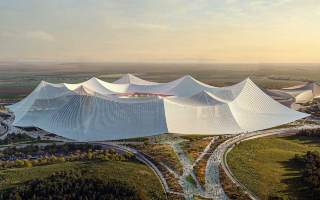Morocco: Grand Stade Hassan II will be "made for the final" of 2030 World Cup
source: StadiumDB.com; author: Miguel Ciołczyk Garcia
 FIFA has a difficult decision to make: it must choose the host of the 2030 World Cup final from among Grand Stade Hassan II, Bernabeu and Camp Nou. However, the architect of the Moroccan giant has no doubts about which is (or should be) the favorite. He assures that he designed the stadium to host the final, and that’s why it will be the largest in the world.
FIFA has a difficult decision to make: it must choose the host of the 2030 World Cup final from among Grand Stade Hassan II, Bernabeu and Camp Nou. However, the architect of the Moroccan giant has no doubts about which is (or should be) the favorite. He assures that he designed the stadium to host the final, and that’s why it will be the largest in the world.
Advertisement
A modern giant created for the final
115,000 seats in the stands is Morocco's main argument for having Grand Stade Hassan II host the final clash of the World Cup 2030. This capacity will allow the Moroccan venue to surpass North Korea's Rungrado May Day Stadium and take over the title of the largest stadium in the world.
Morocco's proposal is to create the largest stadium in the world for the grand finale of the World Cup in Morocco. So it is not only prepared, but also designed, made for this purpose,
assures in an interview with Agencia EFE Tarik Oualalou, co-owner of the Moroccan architectural firm Oualalou + Choi, which, together with Populous, is responsible for the design of the giant from Casablanca.
Although he considers himself a Real Madrid fan, Oualalou claims that the Grand Stade Hassan II will be a much better venue than Santiago Bernabéu, as well as the new Camp Nou. According to him, the stadium will represent the latest generation
and, unlike its urban-located Spanish counterparts, will create space around itself,
making logistics easier.
 © O + C, Populous | There will be huge green spaces under the roof of the Grand Stade Hassan II, inspired by the tents of the moussem festival.
© O + C, Populous | There will be huge green spaces under the roof of the Grand Stade Hassan II, inspired by the tents of the moussem festival.
The battle for the finals intensifies
The first work in Benslimane, a town 38 kilometers east of Casablanca, began in the summer of 2024, and the stadium is expected to be completed in 2028. Although Morocco will invest nearly €500M in its construction, the homes of Real Madrid and Barcelona pose a serious threat to the Moroccan authorities' plan to have the eyes of the world on the stadium in Casablanca on July 21, 2030.
All three stadiums have different strengths and shortcomings, making it difficult to choose. Bernabeu is a symbol of prestige with pioneering technological solutions such as the hypogeum and 360° screen, but its tournament capacity - 78,297 seats - doesn't meet so far the requirements for the final, which set the bar at 80,000 seats.
Camp Nou does not complain about an insufficient capacity - it has 105,000 seats - but technologically it won't be as advanced as Los Blancos' arena. And although it is one of the most famous stadiums in the world, in early February the president of the Spanish federation announced that he wanted the final to be held in Madrid.
On the other hand, Grand Stade Hassan II will be the largest stadium in the world, which is its main asset. The problem is that for now it exists only on paper. The location is also ambiguous - on the one hand, it avoids traffic jams or crowds in the streets, but on the other, it makes it difficult for fans, who will be accommodated mainly in Casablanca, to get there.
The same rating for all three arenas in the FIFA report which was published in December - 4.3 out of 5 points - means that all options are on the table. Of the three arenas, one will become the final venue, another will get the opening match as a consolation prize, and the third will most likely host the semifinal along with Lisbon's Stadium of Light.
Advertisement
 StadiumDB
StadiumDB